【譯文】
2011年8月11日,星期四
專家:植物、動物問題要歸咎于轉基因生物
作者:Jefferson Dodge
星期三縣里開了有關空地上的轉基因作物問題的政策會議,這是次期待已久的會議,其中一位準備在會上作證的專家說,由于除草劑使用的增加,科學家發現植物和動物正在出現新的、令人警覺的類型。
Michael McNeill是位農學家,在愛荷華州的阿爾戈納有自己的農業咨詢有限公司。1969年在愛荷華州立大學獲得定量遺傳學和植物病理學專業的博士學位。從1983年起就一直擔任作物顧問。他是被縣里的官員邀請在8月10日的會議上作證的三位專家之一,這是個農田政策咨詢小組(CPAG)會議。
農田政策咨詢小組,自二月起就一直在開會,在縣里的管理公園和空地的工作人員在開發諸如縣里的地上可以種些什么東西這類的新的農田政策時候,就靠農田政策咨詢小組來反饋人們的意見。這個小組上次開會只是稍稍涉及了敏感的轉基因生物議題;8月10日的這次會議卻是從頭到尾都是在忙這個課題了。
在會前,McNeill告訴Boulder周刊說,他和他的同行正看到由使用草甘膦而導致的嚴重的、負面的影響,草甘膦是除草劑的主要的組成部分。(孟山都,生產除草劑的公司,由于用更換作物的基因的方法使得作物可以抗除草劑,從而導致了爭議。)
McNeill說在這個國家的中西部和其他的地區,如路易斯安那州和密西西比州,水麻,大豬草,藜屬植物,天鵝絨雜草由于在使用了有毒的除草劑之后存了下,從而產生了基因突變,通過自然選擇,成了抗除草劑的雜草了,這些雜草成功地存活下來而且瘋狂地再生。
問題是,農民們自然的反應是對作物使用更多的除草劑,這種做法會產生有害的影響,McNeill說。
“明智地使用除草劑,會產生有用的效果,但是就像任何事情一樣,要是濫用了,就會產生負面的影響,”他說。
McNeill解釋說草甘膦是絡合劑,這就意味著它會鎖住對植物有用的微粒,像鐵,鈣,錳和鋅。
“你給植物噴灑草甘膦,就像在給它傳染艾滋病,”他說。
按照McNeill的觀點,農民們增加除草劑的用量實際上是在傷害他們的作物,因為這會殺死土壤中的作物需要的微量營養物,這些研究的進展情況都已經由該領域的全國的著名專家以文件的形式收錄在數篇科學論文中。他說,例如,在使用了這些有毒物質后,有害的寄生生物如鐮胞菌,疫病菌,腐霉菌的數量呈上升趨勢,而有益的真菌以及幫助植物把礦物質分解為可用狀態的其他有機物的數量卻成下降趨勢。
他解釋說過度使用草甘膦就意味著氧化劑呈上升趨勢,造成植物不能使用的氧化物,這會導致植物低產和更高的對疾病的敏感性。
McNeill承認孟山都會輕易地找到可以殺死這些新型的抗除草劑雜草的新的化學藥品,但同樣,雜草也會輕易地再找到一條可以繞過新的化學藥品的道路。
“這是大自然的植物育種過程,”他說“這非常普遍,所以成了一個嚴重的問題。”
McNeill說這樣狀況會導致大豆的“突然死亡綜合癥”,就是意味著大豆在其進入繁殖階段,死亡的比率增加。他補充說,玉米發生Goss枯萎的幾率更高,自20世紀70年代以來,這就已經成為科羅拉多州的一個難題,而研究表明,草甘膦導致了兩種疾病多發。
而且,根據McNeill的看法,問題還不只局限于植物,它正向食用這些植物的動物延伸。
他和他的同事不斷發現,以轉基因作物作飼料喂養的牛和豬發生不育的幾率和發生早期流產的幾率更高。他補充說,以可疑作物為飼料喂養的家禽表現出生育率下降的趨勢。
為大學,聯邦政府和私人公司工作的McNeill說,他對他的農民客戶建議輪換使用化學藥品--或者就根本不用化學藥品。然而這會加大勞動密集型的程度, 有機耕種的農夫一般會割下雜草而不用除草劑。他說他調查了160,000英畝的傳統農田和5,000到6,000英畝的有機耕作的土地。
“我的客戶就是我的農民,我要為他們找到最佳方案,”他說。“而我的客戶是消費農民產品的消費者,我要為他們找到最好的產品。”
McNeill把除草劑在科學上最終的遭遇和另一種有毒物質做了比較:就如DDT最初被贊美為奇跡般的殺蟲劑而后來卻遭到禁用一樣,研究人員正開始發現草甘膦的嚴重問題。
“一些議題隨著技術而開始出現了,在我們開始使用這些技術之前我們可能要做更多的研究,”他說,“這是個活動得目標。”
另外兩位受邀參加農田政策咨詢小組會議的專家,來自Crop Quest的Kent Davis和來自科羅拉多州立大學的Phillip Westra,在截稿前沒有回電話。
Respond: letters@boulderweekly.com
【完】
【原文鏈接和文本】
http://www.boulderweekly.com/article-6211-expert-gmos-to-blame-for-problems-in-plants-animals.html
Thursday, August 11,2011
Expert: GMOs to blame for problems in plants, animals
One of the experts set to testify at Wednesday’s long-awaited meeting about the county’s policy for genetically modified organisms (GMOs) on open space says scientists are seeing new, alarming patterns in plants and animals due to increased use of the herbicide Roundup.
Michael McNeill is an agronomist who owns Ag Advisory Ltd. in Algona, Iowa . He received his Ph.D. in quantitative genetics and plant pathology from Iowa State University in 1969 and has been a crop consultant since 1983. He was among three experts invited by county officials to testify at the Aug. 10 meeting of the Cropland Policy Advisory Group (CPAG).
CPAG, which has been meeting since February, serves as a sounding board for the county’s parks and open space staff as they develop a new cropland policy on matters like what may be grown on county land. The group has only touched briefly on the hot-button GMO issue in its past meetings; the Aug. 10 meeting was devoted entirely to the subject.
McNeill told Boulder Weekly before the meeting that he and his colleagues in the industry are seeing serious, negative effects produced by the use of glyphosate, which is the primary ingredient in Roundup weed killer. (Monsanto, the company that makes Roundup, has generated controversy by genetically altering crops to make them resistant to the herbicide.)
McNeill says that in the Midwest and other areas of the country, such as Louisiana and Mississippi, weeds like water hemp, giant ragweed, lamb’s quarter and velvet weed have become Roundup resistant through natural selection, due to a particular genetic mutation that survived the poison and therefore reproduced successfully and wildly.
The problem is, farmers’ natural reaction has been to simply apply more Roundup to their crops, which is having deleterious impacts, McNeill says.
“Used judiciously, it can be a useful product, but as with anything, if you abuse it, it can have negative effects,” he says.
McNeill explains that glyphosate is a chelating agent, which means it clamps onto molecules that are valuable to a plant, like iron, calcium, manganese and zinc.
“When you spray glyphosate on a plant, it’s like giving it AIDS,” he says.
The farmers’ increased use of Roundup is actually harming their crops, according to McNeill, because it is killing micronutrients in the soil that they need, a development that has been documented in several scientific papers by the nation’s leading experts in the field. For example, he says, harmful fungi and parasites like fusarium, phytopthora and pythium are on the rise as a result of the poison, while beneficial fungi and other organisms that help plants reduce minerals to a usable state are on the decline.
He explains that the overuse of glyphosate means that oxidizing agents are on the rise, creating oxides that plants can’t use, leading to lower yields and higher susceptibility to disease.
McNeill acknowledges that Monsanto could simply find a new chemical that kills the newly resistant weeds, but the weeds will simply find a way around it again.
“It’s mother nature’s plant breeding program,” he says. “It’s very widespread, and it’s a serious problem.”
McNeill says the situation is causing “sudden death syndrome” in soybeans, which means they are dying at increased rates when they go into their reproductive phase. He adds that corn is showing a higher incidence of Goss’s wilt, which has been a problem in Colorado since the early 1970s, and
studies show that glyphosate causes a rise in both diseases.
And the problems are not limited to plants, it’s extending to the animals that eat them, according to McNeill.
He says he and his colleagues are seeing a higher incidence of infertility and early-term abortion in cattle and hogs that are fed on GMO crops. He adds that poultry fed on the suspect crops have been exhibiting reduced fertility rates.
McNeill, who works with universities, the federal government and private companies, says his advice to his farmer clients is to rotate chemicals — or don’t use them at all. While it is more labor-intensive, organic farmers usually cut their weeds as an alternative to herbicides. He says he consults for about 160,000 acres of conventional farmland and 5,000 to 6,000 acres of organically farmed land.
“My clients are my farmers, and I want what’s best for them,” he says. “And my clients are the consumers who consume the farmers products, and I want what’s best for them.”
McNeill compares the Roundup situation to the way science eventually caught up to another poison: Just as DDT was initially hailed as a miracle pesticide and later banned, researchers are beginning to discover serious problems with glyphosate.
“Some issues are starting to arise with technologies that probably needed more research before we started using them,” he says. “It’s a moving target.”
The other two experts invited to the CPAG meeting, Kent Davis of Crop Quest and Phillip Westra of Colorado State University , did not return calls by press time.
Respond: letters@boulderweekly.com
相關文章
「 支持烏有之鄉!」
您的打賞將用于網站日常運行與維護。
幫助我們辦好網站,宣傳紅色文化!
歡迎掃描下方二維碼,訂閱烏有之鄉網刊微信公眾號






